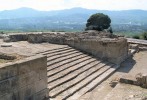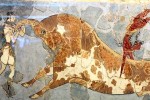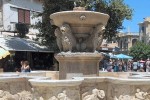Crete

Crete, the biggest island in Greece, with historical significance that is second to none and of extraordinary natural beauty and diversity.
Places of interest in Heraklion town: the archeological museum, the old harbour with the Venetian fortress, the Morosini fountain, St. Catherine’s church with the icons painted by Michael Damaskinos, the Palazzo Ducale and last but definitely not least the famous excavations of the Palace of Knossos.
Places of interest in Rethymnon town: the old town quarters with the Great Gate – what is left of the Venetian Fortifications, the Rimondi fountain, the archaeological museum, the Fortezza in the north of the city on Paleokastro hill. Outside Rethymno are two important monasteries, the Arkadi (23kms southeast) that is linked with memorable events in the island’s struggle against the Turks, and Preveli (36kms south) with a small museum, a great view over the Libyan sea and a river that flows into the water with palm trees on either bank.
Places of interest in Chania area: stroll through the streets of the old town that is an intact neighborhood of the original Venetian buildings. The fortifications date from the 13th century. There is an archaeological and a naval museum, as well as the Historical Archives of Crete that only second in size to the General Archives of the Greek State. There are also two churches, the chapel of Agii Anargiri with old Byzantine frescoes, and the Russo-Byzantine church of Agia Magdalini in Halepa quarters. Antiquities in this area include Phalassarna with its Cyclopean walls, tombs and sculptures carved out of stone, the ancient city of Aptera, about 15kms from Hania south of Souda, where there is a Roman theatre with enormous vaulted cisterns, a temple of Demeter and the Cyclopean walls. From the Byzantine era there is the Monastery of Our Lady of the Angels or Gouvernetou with an impressive facade, the Rotonda of Archangel Michael with mosaic floors and frescoes and the Agia Triada monastery with a fine gate built in 1632.
Natural landmarks in Crete: Gavalochori, 26kms SE of Chania, a traditional settlement surrounded by olive trees and oaks. There is a Historical and Folclore museum there with fine exhibits. The Samaria Gorge, 43 kms from the city of Chania, is the longest in Europe (18kms) and is renowned for its wild beauty and rare species of goats called Kri-kri. Fodele, birthplace of Dominicos Theotocopoulos (El Greco). The Lassithi Plateau, 22kms east of Heraklion, that covers and area of 25,000sq.m. of wooded villages and approx. 7000 windmills.
There are also many caves in Crete, like the Diktaeon Andron, the birthplace of Zeus (48kms east of Heraklion), and Sentoni Zoniana cave, 13kms from Anogia in Rethymno area with the richest natural decoration.
Beaches: In Chania area, Phalassarna, Elafonissi, Paleochora, Maleme, Platanias,
Gerani. In Rethymnon area, Loutro, Preveli, Hora Sfakion. In Heraklion area, Amoudara,
Linoperamata, Matala (all the hippies used to go there in the 70s), Agia Galini, Kokkinos
Pyrgos.
How to get there from Athens: by ferry (8 hours/overnight), by plane (1 hour). There are 4 ports – Chania, Heraklion, Agios Nikolaos and Sitia. There are daily ferries to Chania and Heraklion. There are also 3 airports – Chania, Heraklion and Sitia. There are daily flights to the first two only.
The current (Wed, 7 Jan 2026 04:05pm) temperature in Crete is 14.8°C/58.6°F.
Humidity: 56%


 Legacy Crete island map
Legacy Crete island map































